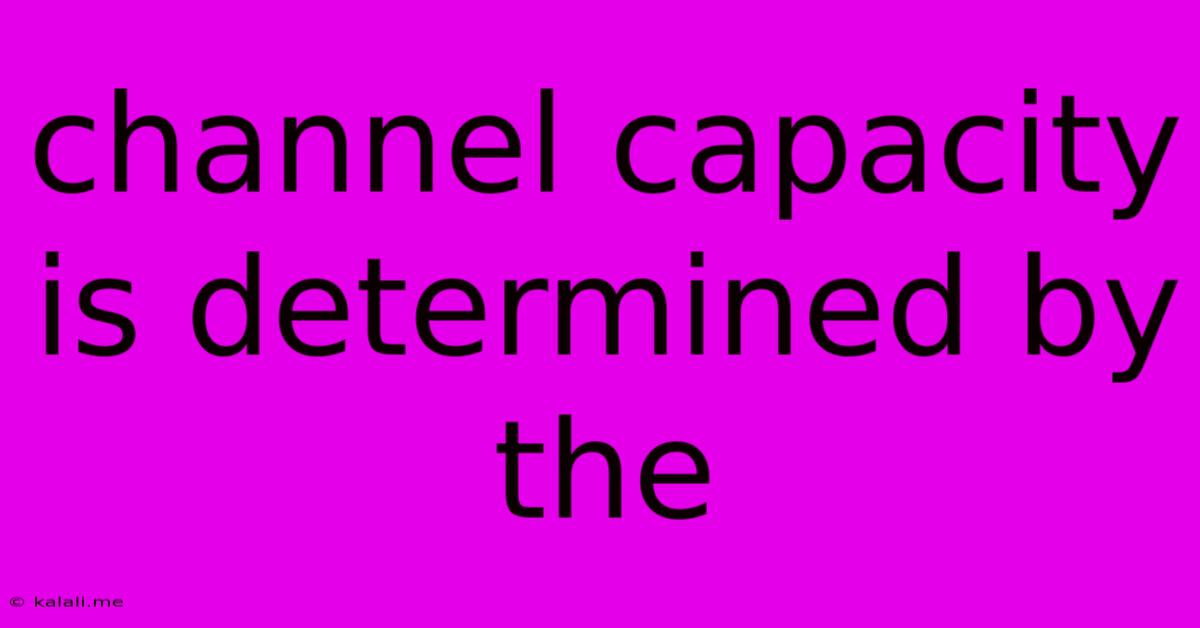Channel Capacity Is Determined By The
Kalali
Jun 14, 2025 · 3 min read

Table of Contents
Channel Capacity is Determined By: Bandwidth, Signal-to-Noise Ratio, and More
Channel capacity, a fundamental concept in information theory, represents the theoretical upper limit on the rate at which information can be reliably transmitted over a communication channel. Understanding what determines channel capacity is crucial for designing efficient and reliable communication systems, from your home Wi-Fi to complex satellite networks. This article explores the key factors influencing channel capacity.
Understanding the Basics: What is Channel Capacity?
Before delving into the determinants, let's clarify what channel capacity actually means. It's the maximum amount of data (measured in bits per second, or bps) that can be transmitted across a channel with an arbitrarily low probability of error. Think of it as the "speed limit" for your communication link. Exceeding this limit leads to data loss or corruption.
Key Factors Determining Channel Capacity:
Several factors interplay to determine the channel capacity. The most significant are:
1. Bandwidth
Bandwidth refers to the range of frequencies available for transmitting data. A wider bandwidth allows for a higher data transmission rate. Think of a highway: a wider highway (larger bandwidth) allows for more cars (data) to pass through at the same time. This is often expressed in Hertz (Hz) or multiples thereof (kHz, MHz, GHz). Higher bandwidth directly translates to higher potential channel capacity.
2. Signal-to-Noise Ratio (SNR)
The signal-to-noise ratio is a critical factor. It represents the ratio of the power of the desired signal to the power of background noise. Noise interferes with the signal, causing errors in data transmission. A higher SNR indicates a cleaner signal with less interference, leading to a higher channel capacity. A noisy channel (low SNR) limits the amount of data you can reliably transmit.
3. Modulation Scheme
The modulation scheme employed significantly impacts channel capacity. Modulation is the process of encoding information onto a carrier wave. Different modulation techniques, like Amplitude Shift Keying (ASK), Frequency Shift Keying (FSK), and Quadrature Amplitude Modulation (QAM), offer varying levels of efficiency. More sophisticated schemes, like QAM, can pack more bits per symbol, increasing channel capacity. Choosing the right modulation technique for the given SNR and bandwidth is crucial for maximizing capacity.
4. Coding Scheme
Error-correcting codes are essential for reliable communication over noisy channels. These codes add redundancy to the transmitted data, allowing the receiver to detect and correct errors. While adding redundancy seemingly reduces the raw data rate, it significantly improves reliability, ultimately enabling a higher effective channel capacity. Efficient coding schemes can significantly boost the reliable data throughput.
5. Interference
Interference from other signals can severely degrade channel capacity. This interference can stem from various sources, including other communication systems operating in the same frequency band or environmental factors. Minimizing interference is key to achieving the maximum channel capacity. This often involves careful frequency planning and the use of filters.
6. Channel Type
The physical characteristics of the channel itself play a role. For instance, a fiber optic cable offers significantly higher bandwidth and lower attenuation compared to a twisted pair copper wire, resulting in a much higher potential channel capacity. The propagation medium and its inherent limitations directly impact data transmission capabilities.
The Shannon-Hartley Theorem: Putting it All Together
The Shannon-Hartley theorem provides a mathematical formula that encapsulates the relationship between these factors:
C = B * log₂(1 + SNR)
Where:
- C is the channel capacity in bits per second
- B is the bandwidth in Hertz
- SNR is the signal-to-noise ratio
This formula highlights the direct relationship between bandwidth and SNR and the logarithmic relationship with channel capacity. It serves as a fundamental theoretical limit, though achieving it in practice requires efficient modulation and coding techniques.
Conclusion:
Determining channel capacity involves a complex interplay of bandwidth, signal-to-noise ratio, modulation scheme, coding scheme, interference, and the channel type itself. Understanding these factors is critical for engineers and researchers to design and optimize communication systems that maximize data throughput and ensure reliable data transmission. The Shannon-Hartley theorem provides a valuable framework for understanding these relationships and setting achievable goals for communication system performance.
Latest Posts
Latest Posts
-
A Group Of Stars Is Called
Jun 14, 2025
-
What Is The Unit For Strain
Jun 14, 2025
-
What Is The Hybridization Of The Central Atom In Pcl3
Jun 14, 2025
-
Which One Of The Following Is Not A Supply Chain Strategy
Jun 14, 2025
-
What Is The Integral Of Sin 2x
Jun 14, 2025
Related Post
Thank you for visiting our website which covers about Channel Capacity Is Determined By The . We hope the information provided has been useful to you. Feel free to contact us if you have any questions or need further assistance. See you next time and don't miss to bookmark.